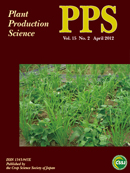Volume 15, Issue 2
Displaying 1-11 of 11 articles from this issue
- |<
- <
- 1
- >
- >|
Crop Physiology
-
2012Volume 15Issue 2 Pages 65-72
Published: 2012
Released on J-STAGE: March 15, 2012
Download PDF (3281K)
(Short Report)
-
2012Volume 15Issue 2 Pages 73-78
Published: 2012
Released on J-STAGE: March 15, 2012
Download PDF (905K)
(Short Report)
-
2012Volume 15Issue 2 Pages 79-81
Published: 2012
Released on J-STAGE: March 15, 2012
Download PDF (614K)
Genetic Resources Evaluation
-
2012Volume 15Issue 2 Pages 82-91
Published: 2012
Released on J-STAGE: March 15, 2012
Download PDF (1787K)
Agronomy & Crop Ecology
-
2012Volume 15Issue 2 Pages 92-99
Published: 2012
Released on J-STAGE: March 15, 2012
Download PDF (1826K) -
2012Volume 15Issue 2 Pages 100-108
Published: 2012
Released on J-STAGE: March 15, 2012
Download PDF (1883K) -
2012Volume 15Issue 2 Pages 109-117
Published: 2012
Released on J-STAGE: March 15, 2012
Download PDF (1039K) -
2012Volume 15Issue 2 Pages 118-124
Published: 2012
Released on J-STAGE: March 15, 2012
Download PDF (677K) -
2012Volume 15Issue 2 Pages 125-131
Published: 2012
Released on J-STAGE: March 15, 2012
Download PDF (689K) -
2012Volume 15Issue 2 Pages 132-143
Published: 2012
Released on J-STAGE: March 15, 2012
Download PDF (1192K) -
2012Volume 15Issue 2 Pages 144-148
Published: 2012
Released on J-STAGE: March 15, 2012
Download PDF (598K)
- |<
- <
- 1
- >
- >|
